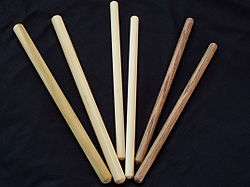桴
| ||||||||
Translingual
Han character
桴 (radical 75, 木+7, 11 strokes, cangjie input 木月弓木 (DBND), four-corner 42947, composition ⿰木孚)
References
- KangXi: page 527, character 6
- Dai Kanwa Jiten: character 14807
- Dae Jaweon: page 915, character 25
- Hanyu Da Zidian: volume 2, page 1217, character 8
- Unihan data for U+6874
Chinese
| simp. and trad. |
桴 | |
|---|---|---|
Glyph origin
| Characters in the same phonetic series (孚) (Zhengzhang, 2003) | |
|---|---|
| Old Chinese | |
| 殍 | *brɯwʔ, *browʔ, *pʰuw |
| 脬 | *pʰruː |
| 捊 | *bruː, *buw |
| 莩 | *browʔ, *pʰuw |
| 哹 | *pu, *bu |
| 浮 | *bu |
| 蜉 | *bu |
| 桴 | *bu, *pʰuw |
| 罦 | *bu, *pʰuw |
| 琈 | *bu |
| 粰 | *bu |
| 烰 | *bu |
| 艀 | *bu |
| 俘 | *pʰuw |
| 孚 | *pʰuw |
| 孵 | *pʰuw |
| 稃 | *pʰuw |
| 郛 | *pʰuw |
| 筟 | *pʰuw |
Pronunciation
Japanese
Readings
Etymology 1

| Kanji in this term |
|---|
| 桴 |
| ばち Hyōgaiji |
| kun’yomi |
Might be a sound shift from buchi (see below), from the sense of striking.
Noun
桴 (hiragana ばち, katakana バチ, rōmaji bachi)
- 桴, 枹: a drum stick for instruments such as the taiko and gong, a percussion mallet
- Synonym: 桴 (buchi) (see below)
- 撥, 桴: in 雅楽 (gagaku, “traditional Japanese court music”), the plectra or picks used to play the biwa lute and shamisen, together with the sticks and other objects held by the dancer in 舞楽 (bugaku, “traditional Japanese court dance”)
Etymology 2
| Kanji in this term |
|---|
| 桴 |
| ぶち Hyōgaiji |
| kun’yomi |
Appears to be the 連用形 (ren'yōkei, “continuative or stem form”) of verb 打つ (butsu, “to strike something, to hit something”).
Noun
- (archaic, possibly obsolete) a drum stick for instruments such as the taiko and gong, a percussion mallet
Etymology 3
| Kanji in this term |
|---|
| 桴 |
| いかだ Hyōgaiji |
| kun’yomi |
From Old Japanese. Found in the Man'yōshū, completed some time after 759 CE.[2]
Appears to be a possible compound, but the ultimate derivation is unknown.
References
- 2006, 大辞林 (Daijirin), Third Edition (in Japanese), Tōkyō: Sanseidō, →ISBN
- c. 759, Man'yōshū (book 1, poem 50), text here
- 1998, NHK日本語発音アクセント辞典 (NHK Japanese Pronunciation Accent Dictionary) (in Japanese), Tōkyō: NHK, →ISBN
- 1997, 新明解国語辞典 (Shin Meikai Kokugo Jiten), Fifth Edition (in Japanese), Tōkyō: Sanseidō, →ISBN
Korean
Hanja
桴 (eum 부 (bu))
- This term needs a translation to English. Please help out and add a translation, then remove the text
{{rfdef}}.
Vietnamese
Han character
- This term needs a translation to English. Please help out and add a translation, then remove the text
{{rfdef}}.
References
This article is issued from
Wiktionary.
The text is licensed under Creative
Commons - Attribution - Sharealike.
Additional terms may apply for the media files.
